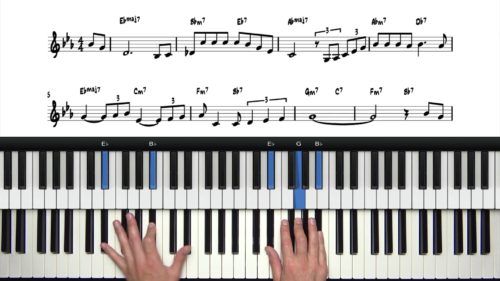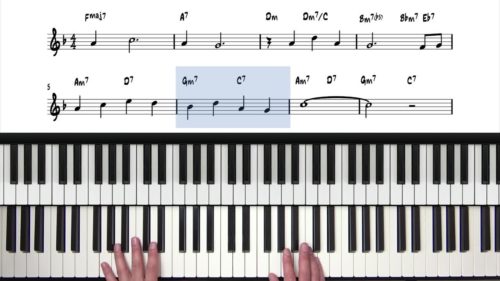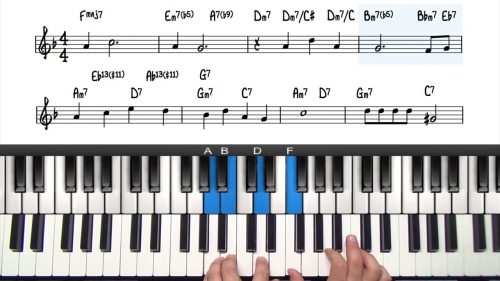Blues Scales & Blues Licks
In this lesson we introduce blues scale material into our improvised solo. There are some important considerations when choosing which blues scale to use and we will explore these considerations and how we can choose the most appropriate blues scale or blues scales from which to derive our improvised melodies.
Analyse The Harmonic Movement
One of the most important considerations is to analyse where the harmony is moving. Looking at the first line of the tune, we can see that in the 2nd and 3rd bars we have a 251 progression. This is a 251 progression in Bb major which is a 251 to the IV chord of the key. Here the harmony is moving towards Bb major which is our point of resolution.
If we want to find a blues scale to play over this entire 251, a good place to start is to take the blues scale of the 1 chord. The 1 chord is a Bbmaj7 and so we’re going to use the Bb major blues scale.
Relative Major & Minor Blues Scales
Just as every major scale has a relative minor scale, every major blues scale has a relative minor blues scale. Using the Bb major blues scale as an example, the relative minor blues scale would be the G minor blues scale. It might be easier to think in terms of the G minor blues scale to the Bb major blues scale and so understand that these 2 scales contain the exact same notes.
There are some instances where I find it more practical to think in terms of the major blues scale and we’ll explore these situations on the 2nd line of the A Section.
Lesson Downloads
-
Blues Scales & Blues Licks File Type: pdf
Practice Tips
-
When searching for an appropriate blues scale, first analyse where the harmony is moving and build a blues scale from the chord of resolution.
-
As a practice exercise always find the relative major and minor blues scale as outlined in this lesson. It's useful to combine our material from both the major and minor blues scale.
-
Another useful method to identify appropriate blues scales is to look for common tones which are consistent in both the harmony and the blues scale in question.
-
An example is using the F major blues scale over the 251 in Bb major. The F major blues scale contains the 3rd and 7th of the Bbmaj7 and so it fits nicely with the harmony and the resolution of the chord changes.









Hello Hayden,
Thanks for these interesting lessons. You speak at the end of this lesson that we will see you in the next lesson with the part B of the song Nearness of you, but I dont find this lesson. Can you help me?
Best regards
Véronique
Hi Véronique,
I’m glad you are enjoying the lessons.
Yes, I plan to add another module to this course and this will focus on the B part of the song. I have added it to my lesson schedule for January and I will ensure it is completed ASAP. Please keep an eye on the course page for updates.
Wishing you a very Happy New Year and talk soon.
Best
Hayden
Thanks for your answer.
Il’s really cool that we can post questions.
Happy New year and best wishes for 2025
Kind regards
Véronique from Switzerland
Hi Hayden,
I hope you are fine.
Could you add this lesson improv about the B section ?
Where can we find the updates of the courses ?
Have a nice day.
Kind regards
véronique
Hi Véronique,
I’m very well thanks – I hope you’re well too!
Please disregard my previous comment – I sent you a link to a seminar on “Georgia On My Mind” and not “The Nearness Of You”.
Yes I still need to finish this course, apologies for the delay.
You might like to check out my recent seminar where we explore diminished and altered scales using “The Nearness Of You”: pianogroove.com/live-seminars/altered-scale-runs-fills-improvisation/
I will create some dedicated lessons on the B Section which incorporates this material.
Talk soon,
Hayden
Hi Hayden,
ok thanks a lot. I have seen these seminars. They are really helpfull.
I’m looking forward to discovering this new improv lesson in Part B.
How will I be notified when it’s available?
Your lessons are really detailed, and I’m learning a lot. Thank you very much.
I’m making progress.
Have a nice day.
Yours sincerely,
Véronique
Hi Véronique,
I will reply to your comment here when it’s ready. I was working on the lesson structure today and I will record it this week for you.
In the interim check out this 5-note improvisation technique over minor chords: pianogroove.com/jazz-piano-lessons/5-note-improvisation/ – as you will use a similar technique for part of the B-Section of this tune.
Talk soon,
Hayden
Thanks, Hayden! It’s really great that you made this video at my request. I saw it was online.
And the link to the minor improv course is very informative too, thank you very much.
Have a wonderful day.
Yours,
Véronique
Hi Hayden,
I got confused with the video improvisation part B of Misty.
I’m looking forward to seeing the improvisation part B of A Nearness of you, very soon.
Good work and thanks again.
Best regards
Véronique
Hi Hayden,
Could you finish this improvise course of part B ?
Sorry to stress you about this.
Best regards
Véronique